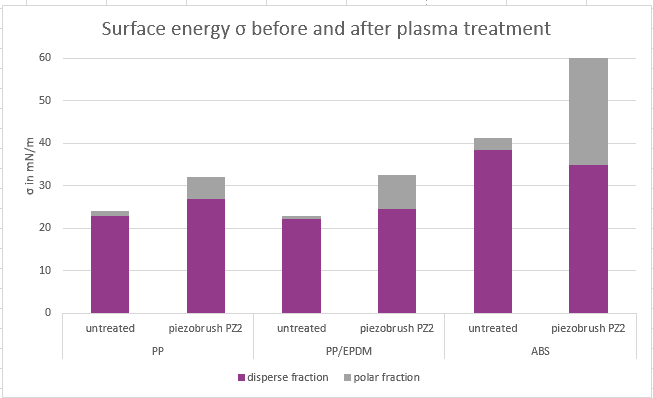Surface tension and pre-treatment – effects of plasma
Students of the degree course in plastics and elastomer technology at the University of Applied Sciences Würzburg-Schweinfurt (FHWS) examined the effects of the plasma handheld device piezobrush® PZ2 on various plastics as part of the internship “Measurement of surface tension and pre-treatment” under the direction of Prof. Dr.-Ing. J. Leiber. The surface energies of the samples before and after the treatment were evaluated using test inks as well as contact angle measurements.
One group of students compared the small 18 W handheld piezobrush® PZ2 with a laboratory corona system (dose: 5000 Ws/m2): Comparably good results were achieved on polypropylene (PP), although the corona system required a shorter treatment time for this. [1] Another group of students also achieved a significant increase in surface energy on PP, but also on PP/EPDM and ABS substrates. [2] The easy handling of the piezobrush® PZ2 was praised and suggestions for process control were given. In their own experiments, the students learned that distance and speed of treatment are important process parameters in plasma processes.
Analysis methods
During the internship the students used two methods for the determination of the surface energy: The analysis based on test inks and contact angle measurements. In comparison, the test inks are easier to handle, but less accurate than contact angle measurements with three test liquids. In the latter method, drops of the respective test liquid are deposited on the surface and then their contact angle is measured. The surface energy determined by this method can thus be broken down into its polar and disperse fractions, the sum of which gives the total value of the surface energy.
Results and conclusion
Overall, the students observed that the surface energies of the examined plastics could be significantly increased by treatment with the piezobrush® PZ2. Due to the functionalization of the surface by the addition of oxygen groups, the increase is mainly visible in the polar fraction of the surface energy, as shown in the visualization of the results [2] in figure 1.

These results were achieved at a process speed of 20 mm/s and a distance of 5 mm between substrate and nozzle outlet of the piezobrush PZ2. Using a laboratory corona system, comparable results can be achieved on PP at 170 mm/s. [1] By working with the piezobrush PZ2 handheld unit, the students were able to impressively demonstrate the influence of treatment speed and working distance on their increase in surface energy: For reproducible results, they recommend the installation of the piezobrush PZ2 handheld device in a fixture that can maintain defined distances and constant speeds. [2] Overall, the students draw a positive conclusion: “However, for use in practical training it is advantageous to have such a compact device. Here it can be shown in a simple way how a corona treatment works, what needs to be taken into account and what effect it has. In addition, such a hand-held device is also very suitable for mobile purposes, e.g. lectures or for small workshops at home” [2].
Sources:
[1] R. Knaub, M. Deininger, M. Jampolski, S. Taumann, J. Ketterer, J. Keller (2019), Praktikumsbericht „Messung der Oberflächenspannung und Vorbehandlung“ im Modul „Analytik und Oberflächen der Kunststoffe“ des Studienganges Kunststoff- und Elastomertechnik an der Hochschule für angewandte Wissenschaften Würzburg-Schweinfurt
[2] A. Schäder, G. Fischer, C. Zier, F. Schneider, S. Götz, D. Gärtig (2019), Praktikumsbericht „Messung der Oberflächenspannung und Vorbehandlung“ im Modul „Analytik und Oberflächen der Kunststoffe“ des Studienganges Kunststoff- und Elastomertechnik an der Hochschule für angewandte Wissenschaften Würzburg-Schweinfurt




